January 23, 2009
Air Date: January 23, 2009
FULL SHOW
SEGMENTS
Federal Court Halts Drilling Near Parks
View the page for this story
In a last minute weekend ruling, a federal judge issued a restraining order on the sale of oil and gas leases near several national parks. Idaho Statesman reporter Rocky Barker tells host Steve Curwood it’s now up to the Obama administration to make the next move on oil and gas exploration in the region. (05:30)
Of Farm Bills and Forests
View the page for this story
The U.S. Department of Agriculture is responsible for policy on everything from food safety to forestry management. President Obama’s pick for the position is Tom Vilsack, the former governor of Iowa. Host Steve Curwood turns to Ken Cook, president of the Environmental Working Group, to look at the challenges that lie ahead for Vilsack. (06:30)
Weathering Climate Change / Bruce Gellerman
View the page for this story
No matter what we do to limit greenhouse gases now, the climate is going to change. The question is: by how much, and can we adapt ecosystems so they're better able to stand the stresses and strains of climate disruption? Living on Earth’s Bruce Gellerman hiked Massachusetts' Mt. Watatic with four experts working to prepare the forest to weather climate change. (12:15)
Harvesting Emissions
View the page for this story
The world's farmers bring us food, clothes, and increasingly - greenhouse gas emissions. Through crop and livestock production and land clearing, the world's agricultural sector is a bigger contributor to global warming than the transportation sector. Economist Sara Scherr, CEO of Ecoagriculture Parters, says it’s time to start looking at farmers as environmental stewards, not just food producers. She speaks with Steve Curwood about techniques that help farmers mitigate and adapt to climate change. (05:50)
ECOtime
View the page for this story
The planet's natural calendar, with its cycles of hibernation, sprouting, fading and rebirth, can seem remote in our techno-filled lives. Tune in to the remedy: ECOtime. This week, we hear about gray days. (01:30)
Sea Lion Seizures / Amy Coombs
View the page for this story
In Alfred Hitchcock’s movie “The Birds,” crazed avians attack people in Santa Cruz, California, inciting panic. Now, something similar is happening in real life, and scientists think they may have discovered why. Amy Coombs reports. (06:45)
The Pluto Files
View the page for this story
Neil deGrasse Tyson didn't mean to get Pluto demoted from planet status; he just wanted people to think about the solar system differently. But changing the number of planets from nine to eight is just what happened when a debate sparked by the astrophysicist’s Hayden Planetarium exhibit - sans Pluto - ended with the re-categorization of the icy rock to "dwarf planet" status. Dr. Tyson tells his story - and the story of Pluto - in his new book "The Pluto Files: The Rise and Fall of America's Favorite Planet.” He talks with host Steve Curwood. (07:15)
This week's EarthEar selection
listen /
download
Rain and sleet hit a window in New York.
Show Credits and Funders
Show Transcript
Host: Steve Curwood
Guests: Rocky Barker, Ken Cook, Sara Scherr, Neil deGrasse Tyson
Reporters: Amy Coombs, Bruce Gellerman
[THEME]
CURWOOD: From Public Radio International - this is Living on Earth.
[THEME]
CURWOOD: I’m Steve Curwood.
President Barack Obama moves quickly to implement his agenda. The inaugural promise…
OBAMA: We will restore science to its rightful place.
CURWOOD: The action: an immediate order creating the right of the public to know about all but the most sensitive government scientific research and rule-making proceedings.
Also, anticipating Obama, a federal judge shuts down a last minute move by President Bush to begin drilling for gas near national parks.
And, a space scientist becomes unpopular when he helps demote Pluto.
TYSON: There's a letter from a girl, Madeline Yost, who said “Dear Dr. Tyson, why did you take away my favorite planet? Here's a picture of it, this is what it looks like, put it back in, write back soon, but not in cursive, I don't know how to read cursive yet.”
CURWOOD: For the love of Pluto and more, this week on Living on Earth. Stick Around!
[THEME]
[NEWSBREAK MUSIC: Boards Of Canada “Zoetrope” from “In A Beautiful Place Out In The Country” (Warp Records 2000)]
ANNOUNCER: Support for Living on Earth comes from the National Science Foundation and Stonyfield Farm.
Federal Court Halts Drilling Near Parks
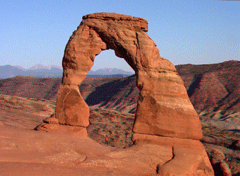
The original Bureau of Land Management decision would have issued leases for oil and gas drilling within sight of Arches National Park in Utah. (Courtesy of the U.S. Geological Survey)
CURWOOD: From the Jennifer and Ted Stanley Studios in Somerville, Massachusetts - this is Living on Earth. I’m Steve Curwood.
FEINSTEIN: It is my great personal honor to present the 44th President of these United States, Barack Obama.
[CHEERS]
CURWOOD: In calling for the nation to act boldly and swiftly Barack Hussein Obama repudiated the ideology, actions and inactions of his predecessor.
OBAMA: We will restore science to its rightful place, and wield technology's wonders to raise health care's quality and lower its cost. We will harness the sun and the winds and the soil to fuel our cars and run our factories.
CURWOOD: On day one President Obama signed an order that alters disclosure rules, giving the public the right to know in all but the most the sensitive government proceedings and documents. This marks a sharp break with the Bush White House in procedures that will affect public health and environmental protection.
Anticipating the change of the presidential guard, a federal judge blocked a controversial last minute move by the Bush administration allowing drilling for oil and natural gas in Utah and Colorado, close to national parks. Rocky Barker is an environmental reporter for the Idaho Statesman, and joins me now for an update.
Hi, Rocky!
BARKER: Good to talk to you.
CURWOOD: So this judge went to work on a Saturday to issue this temporary restraining order. Why? What’s so urgent? What makes this land so special?
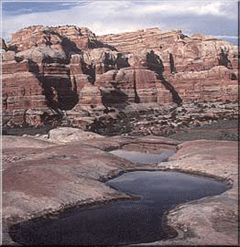
Canyonlands National Park in Utah (Courtesy of U.S. Geological Survey Marli Miller)
CURWOOD: Why do this on a Saturday? Why did he do this over the weekend?
BARKER: I think he wanted to make sure that that decision was clearly stopped until the new administration came. And he made a judgment in that restraining order that I think that a lot of Americans would agree with is he said while there was clearly a national interest to drill for more oil and gas, that interest is not a priority over the interest of protecting our scenic national parks and wild lands.
CURWOOD: Now the judge in this case said that the bureau of land management didn’t do a proper environmental analysis. What was missing?
BARKER: What was missing was they had not done an analysis, according to the judge, of the potential air pollution of the national parks and national monuments in the area, Arches, Canyonlands National Parks and Dinosaur National Monument.
CURWOOD: Now this is not just Utah but this is also Colorado as well now.
BARKER: That’s right. It’s a regional effect. There were about 149,000 acres affected originally. But the BLM when they did this, forgot to talk to the National Park Service, and so they had to go back, consult with them, and they took it down to about 110,000 acres. About three million acres would have been affected from a scenic standpoint.
CURWOOD: Now there’s another unusual element of this case. As I understand it, there’s a 27-year-old University of Utah student named Tim DeChristopher who well – could we say he crashed the party at the lease auction and bought an almost $2 million lease with really no intention or means of paying for it. Can you tell me about that?

The original Bureau of Land Management decision would have issued leases for oil and gas drilling within sight of Arches National Park in Utah. (Courtesy of the U.S. Geological Survey)
BARKER: Yeah, it’s quite interesting. He went there thinking he was just gonna protest, and then at the last minute he thought, well, why don’t I just bid. And he did. He won leases on thirteen parcels and drove the price up on a whole lot of the other ones. By doing this, the BLM went – you know was very angry, and the U.S. Department of Justice actually has begun looking at him for fraud. But eventually he came up with the $45,000 required to hold the leases temporarily, and so he might get off that fraud case. But it is still pending, and he still – you know – he’s still in harms way.
CURWOOD: Rocky, let’s talk about the big picture for a moment. How does this case here involving Arches National Park and Canyonlands and Dinosaur National Monument, how does this fit in with the overall trend you’ve seen under the Bush administration in terms of oil and gas lease sales in the west?
BARKER: For the last eight years, particularly the first four years, they were so aggressive, they put oil and gas wells in places that are particularly important habitat for sage grouse and other desert species. In fact, about the same amount of land was leased during the Bush years as was leased during the Clinton years, except during the Bush years it was a lot of the more sensitive lands that the Clintons and clearly the Obama administration are not going to approve.
CURWOOD: What does it mean now to have a temporary restraining order and how does the arrival of the Obama administration play into what’s going on.
BARKER: Well, a temporary restraining order stops them from doing anything. They can’t move this forward at all. Clearly, if there was a continuing Bush administration, they would push this. They would continue to try to get these sales through. They would have the option of pulling the case back, doing the analysis on air pollution and moving forward. Now though, that the Obama administration is coming in, who has already told us – they’ve been clear in the transition before the new administration took over – that they oppose these. They have the option of just simply dropping the case.
CURWOOD: Rocky Barker is an environment reporter for the Idaho Statesman in Boise. Thank you so much, sir.
BARKER: Thank you.
Related links:
- Bureau of Land Management
- Rocky Barker’s Website
- Tim DeChristopher’s Website
Of Farm Bills and Forests
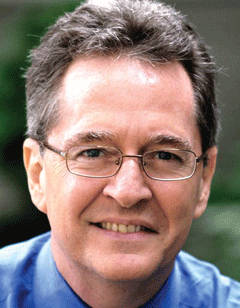
Ken Cook
CURWOOD: Okay now, here’s a riddle – what federal agency hands out billions of dollars, sometimes to people who promise NOT to work, is in charge of our nation’s trees AND inspecting our food?
Well, that’s the U.S. Department of Agriculture, which develops policy on food, hands out billions in farm subsidies…and oversees the Forest Service. Former Iowa governor and presidential candidate Tom Vilsack has been confirmed by the Senate to lead the USDA.
Joining me to take a look at the challenges that lie ahead for the new Secretary of Agriculture is Ken Cook, president of the Environmental Working Group. Mr. Cook, tell me about Tom Vilsack and his record as Iowa’s governor.
COOK: I think he’s a listener. I think he’s someone who’s going to use his time in office to wade into tough issues, whether it has to do with forest service rules, whether we will spend more money for more nutritious school lunches, whether we’ll cap farm subsidies – all kinds of contentious issues, Steve. I think he’ll weigh in and listen to all sides. I don’t feel like he’s so beholden to agribusiness or so oriented towards conservation or the environment that we can really tell at this stage how he’ll come down on and what advice he’ll give to the President on any of these issues at this stage.
CURWOOD: Ken, let’s go through a few issues now that Tom Vilsack is going to face. At the top of the list is ethanol. Ethanol got, I think, three quarters of all the federal renewable energy tax credits in 2007. How do you see that changing as Mr. Vilsack takes over now at USDA?
COOK: Well I would say that two years ago, there was much less questioning of corn-based ethanol than there is today. When food prices went up, when there has been new evidence of the impact of ethanol in terms of causing land to come into production and, as a result of that, causing increase in greenhouse gases. Vilsack has said on the one hand that he has been a big supporter of corn-based ethanol. He has also said that he thinks that that needs to give way to something that is better, but no one has really described very well just how superior the next generation of ethanol might be. I think Vilsack is coming in at a very important time where we need to have a much more robust discussion about the future of biofuels than we’ve had so far. And I think everyone is looking to see whether he will come to it with the judicial temperament that he’s known for. And whether he will be willing, if it comes down to it, to take on, in some cases, his own home state interests and friends in the ethanol industry and say, “Wait a minute. Maybe we’ve gone too far to fast on corn ethanol. We need to rethink this.”

Ken Cook
CURWOOD: The USDA handles the Forest Service, something that many people aren’t aware of. How much of a conservationist do you think Tom Vilsack will be when it comes to roadless rules or protecting something like the Tongass National Forest, which is a major temperate rain forest for the whole planet.
COOK: Well – he does not come to the job with much of a track record at all. Coming from the Midwest, where these national forest issues are not nearly as heated as they are, for example, in Alaska where the Tongass National Forest is a critical and very controversial issue. I think what we’ll have to look for again is his conservation temperament, will that come through? Will he err on the side of conservation or will he heed the concerns, particularly in this tough economic period we’re in, to create jobs by allowing more lumber to be cut from national forests. I think the key thing there is to look to who is appointed as the head of the Forest Service, the chief, and then, above that position, the undersecretary for the forest service and natural resources will be a key position. My sense is he’ll probably tilt toward conservation.
CURWOOD: During the presidential campaign Sarah Palin, vice presidential Republican candidate, drew a lot of criticism for seeming to endorse the shooting of wolves from airplanes. But this is something that the USDA does as part of its quote “wildlife services” to manage predatory species like coyotes and wolves. How do you think Tom Vilsack will handle this issue of shooting wolves from airplanes?
COOK: That’s a good question. I hope he comes down clearly on the side of dropping that practice and focusing again on our ability to conserve wildlife species at the same time we have a prosperous economy. I don’t think he’s going to come into this with the same kind of attitude that we saw in the last administration where natural resources that are owned by the public were seen as something that should be turned over as quickly as possible to private interests. I don’t think he comes into the job with that orientation at all. But I think on very difficult issues like predator control, he’s going to be up against not just the outside interests who want to continue past practices, but probably a considerable bureaucracy or portion of it within the various agencies who want to continue that too.
CURWOOD: In sum, Ken Cook, what are your hopes for the USDA under the Obama administration?
COOK: Well, I hope it goes back to being what Lincoln intended, since we started with an inauguration that was so steeped in Lincoln’s tradition. He called it the ‘People’s Department’ when he established it. It needs to be the people’s department again. It can’t be the agro-business department, it can’t be the lumber department, it can’t be the animal slaughterhouse department. It has to be the people’s department. Protect food safety, value conservation highly, even if it means at the expense, in some cases, of maximum production. Take care of the hungry. He has the entire food stamp program under him, the entire school lunch program under him. So he’s really got an opportunity to step in and say, “This is once again going to be the department as Lincoln intended it. And we’re not going to be beholden to special interests. We’re gonna open up our doors here and listen to everyone, and when we act, we’re going to act in the public’s interest, not just in the interest of the big dogs.”
CURWOOD: Ken Cook is the president of the Environment Working Group in Washington, D.C. Thank so much, Ken.
COOK: Thank you.
Related link:
The Environmental Working Group
[MUSIC: Madrid “Tiera Del Fuego” from Warm Waters (Aporia Records 2003)]
CURWOOD: Just ahead – weathering climate change. Keep listening to Living on Earth!
[CUTAWAY MUSIC: Marco Benevento: “Seems So Long Ago Nancy” from Me Not Me (Hyena Records 2009)]
Weathering Climate Change
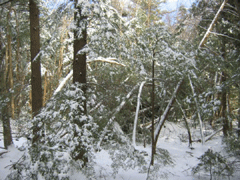
Trees damaged by an ice storm. (Photo: Robert Kluin)
CURWOOD: It’s Living on Earth. I’m Steve Curwood.
The rise in greenhouse gas emissions means that the earth’s climate is already changing.
How much will vary from place to place - from profound to subtle. Some locations will suffer more severe floods and storms, other places will become drier. Some will get hotter, and some could even get colder, for a time. But while there is no way to avoid some degree of climate disruption, we may be able to help ecosystems adapt. Living on Earth’s Bruce Gellerman recently took a hike with four experts to learn what is being done to adapt one forest to the effects of a shifting climate.
[SOUND OF WALKING ON SNOW]
GELLERMAN: The air is crisp, cold and clear as John Scanlon, hikes up Mt. Watatic in north central Massachusetts.
SCANLON: Let me just get up on the high side of the tree, it’s the forester in me.
GELLERMAN: Scanlon, a forestry project leader with the state’s Division of Fisheries and Wildlife is looking for signs of climate change.
SCANLON: Here at Mt. Watatic we have examples of some of the types of forested habitats that are likely under the emerging climate change scenarios to be disrupted or potentially even lost from the commonwealth of Massachusetts, specifically spruce fir forests, which we’ll hike up to on Mt. Watatic and resident northern hardwood forests.
[SOUND OF WALKING ON SNOW]
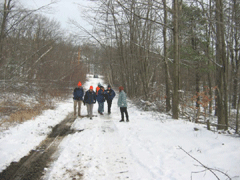
(Photo: Robert Kluin- Manomet Center for Conservation Sciences)
SCANLON: It takes a while. There we go. There we go. Once the teeth bite in we’re all set.
GELLERMAN: Oo, it smells good.
SCANLON: Yeah, right. Oh it’s great when you’re coring things like a yellow birch and black birch give off a real nice wintergreen smell.
[SOUND OF QUIET WOODS]
GELLERMAN: This tree seems fine. But biologist Hector Galbraith Director of the Climate Change Initiative at Manomet Center for Conservation Sciences says look around, and you will find evidence of warming here.
GALBRAITH: There are indicators which I think are showing fairly conclusively that we’re already seeing the sorts of ecological changes we would anticipate under climate change - changes in times of breeding and hibernation and migration schedules of organisms, I’m pretty confident that we’re looking at a climate change signal already.
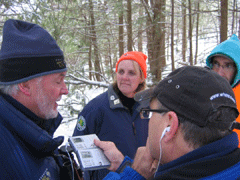
Bruce Gellerman interviews Andy Finton. In the background, from left to right: Hector Galbraith, Mary Griffin, John Scanlon. (Photo: Robert Kluin)
GELLERMAN: Joining state forester John Scanlon and biologist Hector Galbraith and me on our hike up Mt. Watatic is Mary Griffin, Massachusetts Commissioner of Fish and Wildlife. She says the department’s computer models anticipate subtle but significant changes.
GRIFFIN: They’re predicting that winters are gonna get one and a half to three and a half degrees Fahrenheit warmer than they already are, so that will have dramatic impact on habitats and fish and wildlife species. One animal that’s here in Mt. Watatic in the spruce fir habitat is the snowshoe hare, and that’s a species that the Union of Concern Scientists and other biologists predict is likely to decline as temperatures warm.
[SOUND OF WALKING ON SNOW]
GELLERMAN: Ecosystems are infinitely complex and climate change models only hint at the exquisite nature of a place. So here in Massachusetts a unique team has come together. It’s a collaborative effort, bringing together state officials, applied scientists, field researchers and non-governmental organizations leveraging their expertise and experience to find habits affected by climate change and help them adapt.
Andy Finton is director of conservation science with the state chapter of The Nature Conservancy.
FINTON: Bruce, this is - these are birch seeds.
GELLERMAN: What’s that?
FINTON: Seeds of birch.
GELLERMAN: Where did you get that?
FINTON: There’s a little birch over there. But you’ll see them scattered on the snow like this. And I certainly hadn’t thought of this until coming out here today but one of the projections is that we’ll get more precipitation as rain instead of snow. Now these birches, there are four to five species native to Massachusetts are adapted to falling on snow and blowing across that crust of snow to disperse. Now if we don’t have snow on the ground that’s going to limit the dispersal. Now, birches aren’t threatened but this is something that just came to me, about the kind of subtle network of events that could be triggered by changes to our climate patterns.
[SOUND OF WALKING ON SNOW]
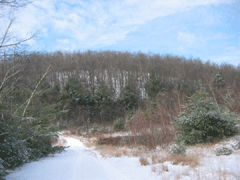
Mt. Watatic. (Photo: Robert Kluin)
SCANLON: Bruce. I wanted to stop here, and let me show you this here, We’re approaching this extensive sugar maple stand on the north side of Mt. Watatic, and you can see first hand - we’re probably some of the first people to see this - all of the obvious damage, all the tree crowns, broken from the recent ice storm.
GELLERMAN: Look at that.
SCANLON: That’s all you’re seeing, is extensive damage to the crowns of these maples from the recent ice storm.
GELLERMAN: All these trees got whacked? Oh yeah.
[SOUND OF WALKING ON SNOW]
SCANLON: And people have to understand when it comes to climate change it doesn’t have to be huge changes. One or two degrees change in temperature can mean what was going to be a snowstorm can become an ice storm giving us this tremendous damage.
[SOUND OF WALKING ON SNOW]
GELLERMAN: The ice storm was one for the books and perhaps the specter of things to come. As temperatures rise, the cold water brook trout found around here will lose its habitat and perhaps so too the Blackburnian Warbler which stops in the Watatic forest as it migrates. They’re just a few of the keystone species that call this place home, says fish and wildlife Commissioner Mary Griffin.
GRIFFIN: I just wanted to point out we’re coming upon some deer tracks. That’s white tail deer tracks in the snow.
GALBRAITH: We’ve finally gotten past the deer in the headlight stage with climate change impacts -- what’s climate change going to do to us -- and we’re beginning to think now what we’re going to do in response.
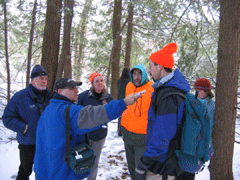
(Photo: Robert Kluin)
GELLERMAN: Climate scientists Hector Galbraith.
GALBRAITH: The state of Massachusetts has done a terrific job in preserving some of these systems. The question is how do we continue doing that terrific job in the future under climate change. This is the adaptation question.
GELLERMAN: The time for action is now, warns Dr. Galbraith, because we may not have as much time as we thought to adapt ecosystems for what’s in store.
GALBRAITH: You know we tend to think about climate change and habitat responses as long slow, linear responses; that may not be the case. There may be abrupt changes in habitats brought on by changes in stochastic events like frequent ice storms and tree damage, like increased frequency of insect attacks, like increased frequency of fire. So what we may see in the habits we’re seeing today may be steep changes rather than slow gradual changes.
Here’s a potential example. I’m not saying it will happen, but this is a possibility: The winters become warmer. The over-winter survival of tree pests, insect pests, is enhanced or the number of generations those insect populations can raise in a year is increased. So winters become warmer, more insects to attack trees. Because there’s more insect attack, there’s more dead wood, more fire –bingo - you may have a rapid transition from forested habitat to something totally different.
SCANLON: Just to add to what Hector was saying.
GELLERMAN: Forester John Scanlon.
SCANLON: Those type of changes that could occur with the greater survival of insect pests could have a direct impact on the Hemlock Wooly Adelgid, which is an invasive insect species that was introduced from Japan and has killed large hemlock cover in Connecticut. It was originally expected to sweep through Massachusetts but their progress slowed by the cooler winters. However, now that winters are warming the Adelgid are expected to cause extensive mortality of hemlock forest throughout Massachusetts.
GELLERMAN: So, you know, what if anything can you do about that kind of thing?

Trees damaged by an ice storm. (Photo: Robert Kluin)
GELLERMAN: But can you do that? Is this like a finger in the dike - I mean nature’s force is going to be so ferocious.
GALBRAITH: The trick is to increase resilience. So that when climate change comes along these systems, the eco systems might not be affected as much. So take out other stressors, contaminants, so on and so forth, and invasive species and maybe we can amplify the resilience of the effected communities.
GRIFFIN: One of the strategies we have to try to create resilient habitats is to protect large intact interior forests and blocks of land like where we are today. So the state has protected over 4,000 acres of open space and we work with partners to protect the most valuable habitats. So in protecting those habitats like the spruce fir forests or the northern hardwoods where we are today, we’re protecting places for wildlife to feed, breed and to find new resting areas and that makes them more resilient to the stressors of climate change.
GELLERMAN: But you know, right over there is New Hampshire - if they don’t do anything or they don’t do something in support of what you’re doing here in Massachusetts, can that effort just come to naught?
GRIFFIN: We’re all more interrelated by the global problem like climate change. The state of Massachusetts has been working with some of our neighboring states to protect these intact corridors with other states. We recently bought a large 5,000-acre piece of property half in Connecticut, half in Massachusetts. Last year we protected an 8,000-acre block with the state of Rhode Island. So we do work across state boundaries because biodiversity knows no boundaries.
GELLERMAN: Adapting the hemlocks at Watatic to climate change might mean thinning the tops of trees to let more light in or removing ground cover to help seeds take root. Cold-water brook trout could benefit by tearing down dams creating cooler streams.
Learning to adapt an ecosystem to the stress and strains of a changing climate also means adopting a new model for managing environments, says Dr. Hector Galbraith
GALBRAITH: I think the model we’ve created among ourselves is a really good model. A year ago, if we were having this conversation, I would have said that Massachusetts is the only place in the union who are doing this, but there are other points of light that are starting to emerge in the last six months. And I’d like to think some of those have been influenced by the work we’re doing in Massachusetts. For example Texas, the state of Texas, is now taking very seriously adaptation to climate change.
And you know, let’s be honest about this. There are some habitats we probably can’t do anything about. So there are some hard decisions coming up. You know we can all talk about here are the various things we can do but climate change is going to have fairly serious impacts on our ecosystems and we have to come to terms with that.
GELLERMAN: Climate disruption will make winners of some habits and species and losers of others. Right now, Massachusetts is creating a vulnerability index to figure out which ecosystems in the state will be adversely affected in the coming years and what, if anything, can be done to adapt them to the changing climate.
For Living on Earth, I’m Bruce Gellerman.
Related links:
- The Manomet Center for Conservation Sciences
- The Massachusetts Department of Fish and Game
[MUSIC: The Isness “Go Tell It To The Trees Egghead” from The Future Sound Of London (Hypnotic Records 2002)]
Harvesting Emissions
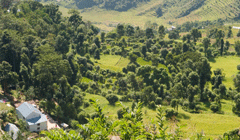
Agroforestry—combining trees and shrubs with crop and livestock production—is important for smallholder farming in Nepal. Photo: (Photo: Sajal Sthapit)
CURWOOD: Agriculture is responsible for about a third of the world's greenhouse gas emissions - more than the transportation sector. About half of those emissions come directly from crop and livestock production, and much of the rest from land clearing and degradation for food production.
Sara Scherr is an economist and head of Ecoagriculture Partners. She wrote an article on agriculture and climate change in this year’s State of the World book by the Worldwatch Institute. Ms. Scherr says changing the way we farm could be one of the least painful and most effective ways of cutting emissions.
SCHERR: One of the most interesting tidbits of knowledge that I learned in the past year is that if you take a cow and a calf in beef production in one of our intensive feedlot systems here in the U.S., that that pair of animals actually emits more in a year than a midsized car in terms of greenhouse gas emissions.
CURWOOD: So, you could either drive an electric car or quit eating meat. Is that what you’re telling me?
SCHERR: Well quit eating meat or make sure that you eat meat from kind of a sustainable live stock production system.
CURWOOD: How could one make a sustainable meat production that wouldn’t add to climate change?

Sara-Scherr_small.gif
SCHERR: Well, so much of the world’s annual crop production is used to feed cattle. And a lot of that could be substituted for by returning to having animals instead graze on pasture. And if you have perennial pastures, long lived grasses, you can actually produce very high levels of meat and dairy production without having to depend upon the use of a lot of grain. Apart from what they eat, one of the big problems for livestock is actually the gases that they produce in their stomach and the manure and waste that they produce because those are very full of a particularly powerful greenhouse gas called methane. So there’s a number of approaches that are being used to try to reduce those. One of them is trying to use the manure in clever ways, by actually using the manures and the other wastes from livestock as a source of biogas. So we have a lot of really – you know thousands and thousands of farms around the world heating their buildings with the waste that came out of their live stock production.
CURWOOD: How does tilling the soil increase CO2 emissions and what is no till agriculture anyway?
SCHERR: Well, if you look at all the different places that carbon is stored in the world, it turns out that the third most important sink is actually the world’s soils. And the process of conventional agricultural tillage, where you take a plow or other implements and turn the soil around at the beginning of the cropping season – actually every time you do that, you release a large amount of carbon from the soils. So one of the things that’s been developed in modern agricultural systems over the last couple of decades is something that’s called minimum tillage or even no till systems that really try to not turn the soil around very much. They manage soil quality and they manage the weed problem through other kinds of methods that don’t require turning that soil around.

Agroforestry—combining trees and shrubs with crop and livestock production—is important for smallholder farming in Nepal.
Photo: (Photo: Sajal Sthapit)
SCHERR: Well, I think this is the exciting thing about what’s going on right now in terms of the reconsideration of how we do agriculture production, because actually a lot of the things that we do, that cost money and cause environmental damage actually don’t contribute that much to agricultural production. So a lot of the no till systems and low till systems farmers like a great deal because they can produce just as food with them for a lot less cost. So it’s a win for the environment, a win for farmers and a win for food production.
CURWOOD: Of course climate change is not only affected by agriculture. It works the other way around. I mean climate change is gonna have a big effect on agriculture. So, how do the techniques that you’re talking about help farmers prepare for the warmer temperatures that are coming?
SCHERR: One of the advantages of the approaches for mitigating climate, which is to get more organic matter in your soils, is that those kinds of activities actually make the farming system much more resilient. High organic matter soils actually hold water better. So that if you start having much more erratic rainfall they’re going to be less susceptible to loss of the harvest. The other things is you’re gonna have more diversity within the farming system, in terms of different kinds of plants and different kinds of products. And that’s going to reduce the risks to farmers of climate that can’t be predicted.
CURWOOD: So how then does the world encourage these agricultural techniques?
SCHERR: Most of us think about farmers as producing food, which of course, is the major thing we want them to do. But more and more we realize that farmers are actually the major stewards of our ecosystems around the world, by far - far more than public protected areas or other kinds of local lands. The farmers are the stewards. And we need to be thinking about them and their role, not only as producers of food, but also as producers of ecosystem services. So, I think, we need to be rethinking everything from our public subsidies and what do we subsidize farmers to do and increasingly we need to subsidize them not for producing food we don’t want, but for producing the ecosystem services that we need.
CURWOOD: Sara Scherr is president and CEO of Eco Agriculture Partners, one of the organizations that contributed to this year’s State of the World study by the Worldwatch Institute. Thank you so much, Sara.
SCHERR: Thank you very much. It was a pleasure to be here.
Related links:
- To learn more about climate change and land use, click here
- Ecoagriculture Partners
[MUSIC: Carlos Santana - “Europa” from Multidimensional Warrior (Legacy Records 2008)]
CURWOOD: Just ahead - the public’s love affair with Pluto. Stay tuned to Living on Earth.
[CUTAWAY MUSIC: Grand Pianoramax: The Space Race (East Meets West) from Grand Pianoramax (ObliqSound Records 2006)]
ANNOUNCER: Support for the Environmental Health Desk at Living on Earth comes from the Cedar Tree Foundation. Support also comes from the Richard and Rhoda Goldman fund for coverage of population and the environment. And from Gilman Ordway for coverage of conservation and environmental change. This is Living on Earth on PRI, Public Radio International.
ECOtime
CURWOOD: It's Living on Earth, I'm Steve Curwood.
January - it’s a hazy shade of winter and daylight is scarce. The folks at the ECOcalendar project capture cosmic moments like this in what we call ECOtime.
[ECOTIME THEME]
HARDMAN: Gray days. It's dark now when you rise, and dark again before you retire, and the days rarely brighten up, instead they're gray. It's not because the earth has moved further from the sun, no, it's because the earth is tilted on its axis, and the North Pole is tipping away from the sun right now.
In the summer, the North Pole is tilted toward the sun, and the sunrays shine almost straight down. But now the sun is low in the sky, and its rays have to pass through lots of earth's atmosphere to get here. That's lots of possible dark gray clouds, fog and mist to block and bounce the light. So, the bright yellow of the sun is seen as bone white by the time it finally penetrates earth's atmospheric filter.
CURWOOD: That's Chris Hardman with ECOTIME, part of the ECOcalendar project.
For more information, go to loe.org.
Sea Lion Seizures
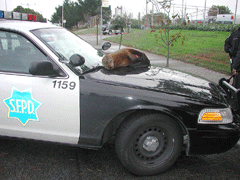
A sea lion disoriented from brain damage due to Domoic Acid poisoning. (Courtesy of the Marine Mammal Center)
[SOUNDS OF ALFRED HITCHCOCK’S “THE BIRDS”]
CURWOOD: Few scenes in movies are scarier than the attacks of the vicious avians in Alfred Hitchcock’s thriller “The Birds”
[FROM MOVIE: “I THINK THESE WERE CROWS. YES, HUNDREDS OF THEM. YES, THEY ATTACKED THE CHILDREN, ATTACKED THEM.”]
CURWOOD: In the 1963 thriller, crazed birds terrorize residents of the northern California coast.
Though the film was based on a short story, it may have also been influenced by a real life bird poisoning that occurred just a few miles from the home of Alfred Hitchcock. Since then similar cases have been documented around the world.
And scientists now believe they have identified an ocean toxin that causes suffering and erratic behavior in marine animals. Amy Coombs has the story.
COOMBS: In 1961, about two years before the movie “The Birds” was released, real life residents in the beach town of Capitola awoke to birds slamming into their rooftops. The suburb of Santa Cruz was covered with dead sea birds and bits of disgorged fish. But University of California, Santa Cruz professor Raphael Kudela says unlike in the film, the birds weren’t trying to hurt anyone.
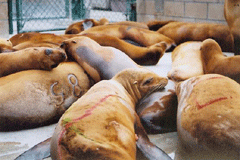
Sick sea lions at the Fort MacArthur Marine Mammal Center. (Courtesy of the Fort MacArthur Marine Mammal Center)
KUDELA: The movie suggested they were actually attacking people. What was probably happening is they were poisoned and they were disoriented and they’re just simply flying into things.
COOMBS: According to the local paper, Alfred Hitchcock did request news reports to use as “research material for his latest thriller.” At the time, people thought the birds had lost their way in the fog. But scientists now say domoic acid—a toxin produced by sea algae--is to blame for the strange behavior.
KUDELA: Domoic acid is a neurotoxin and so if you get enough of it in humans or in marine mammals, it actually causes brain damage. And it comes and goes, and every few years we have a big outbreak. Often times there will be deaths of California sea lions or dolphins or brown pelicans.
COOMBS: More and more sea animals are being poisoned by domoic acid. Each year the toxin kills hundreds of California sea lions that eat contaminated fish. Veterinarian Frances Gulland and her staff see the suffering at their rescue center located at the North end of the Golden Gate Bridge.
[SOUND OF SICK ANIMAL BLEATING]

A California Sea Lion takes a break from swimming. (Photo: Raphael Kudela, Courtesy of the University of California, Santa Cruz)
GULLAND: Do you want influenza? – Oh yes, are there forms in there? I guess I am going to run and go get some – Can we move that animal to C5?
This is the one that was having seizures and was picked up on the beach yesterday.
COOMBS: Domoic acid binds tightly to excitatory neurons, and causes a range of erratic behavior. As volunteer Lee Jackarel prepares a mesh net, he says sick sea lions are also extremely sensitive, and prone to over react when approached.
JACKAREL: So we have a long thin net that we will put over his head that helps constrain his movements so it’s easier to restrain him. And he will not enjoy that and he will try to get away from us and probably yell at us a bit and try to bite us.
COOMBS: As the researchers walk into the chain link enclosure, the sea lion spasms and tries to run away. Once trapped in the net, it takes five researchers to hold down his fins, take blood and administer treatments.
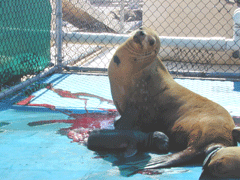
Sea lion with premature pup. (Courtesy of the Marine Mammal Center)
[SEA LION BARKING]
COOMBS: Despite the creature's misery, Gulland says this sea lion is lucky. In many cases the debilitating seizures cause so much brain damage that the animal dies. This is why more than half of the rescues have to be put to sleep, and many more die unnoticed at sea. Again veterinarian Frances Gulland:
GULLAND: Currently in California it’s probably the commonest form of disease in the animals we see, so I would say it’s the most important threat. And interesting thing, or the reason to be concerned is it doesn’t just cause seizures in adult animals, but it also crosses the placenta in pregnant females and can damage the developing fetus. So it can cause abortions and it can cause death of the newborn pup.
COOMBS: Scientists have known for a long time that domoic acid is produced by a sea algae, or plankton, called Pseudo-nitzschia. But that only happens only sometimes. The algae is usually benign. The question that has plagued them is what makes the plain algae suddenly start producing the toxin?
[LABS SOUNDS]
COOMBS: This is why Raphael Kudela’s lab is filled with beakers of Pseudo-nitzchia. Kudela shakes a bottle of the filmy algae. He says he thinks a form of nitrogen called urea makes the algae produce the toxin.
KUDELA: This is Pseudo-nitzchia. Pseudo-nitzschia multiseries will double its toxicity when we give it urea to grow on.
[LAB SOUNDS]

A sea lion disoriented from brain damage due to Domoic Acid poisoning. (Courtesy of the Marine Mammal Center)
[LAB SOUNDS]
COOMBS: So far, Kudela says, urea is the only chemical he's found that makes the algae increase its domoic acid production.
[LAB SOUNDS]
COOMBS: Having identified urea, the next question was whether it was present in the ocean. Kudela took water samples, and it turns out that urea levels are high enough to cause a problem.
KUDELA: When we measured things at the Santa Cruz Municipal Warf, or in the San Francisco Bay, we can measure quite high concentrations of urea. Often times it can be the largest source of nitrogen in the water.
COOMBS: Those findings appear in the November issue of the journal Harmful Algae. So the burning question now is: Where is all the urea coming from? James Cloern, a biologist at the US Geological Survey says that with urea, the arrows usually point to humans.
CLOERN: When we think of urea – which is an excretory waste product of vertebrates – we think of things like untreated sewage or runoff from animal feedlots.
COOMBS: Northern and Central California do have livestock, as well as people living with older, perhaps leaky septic systems. Urea can also come from garden fertilizers, like Miracle-Gro. Cloern says we’re still figuring out what's causing the increase in domoic acid poisonings.
CLOERN: This new work is important because it gives us a strong clue that one of those factors is the presence of urea, which we associate with land sources.
COOMBS: Some researchers like Kudela and the veterinarian Gulland hope we won't have to wait for certainty. They hope coastal communities will begin to watchdog urea pollution as a precaution. For Living on Earth, I’m Amy Coombs.
[MUSIC: Impossible Party “Stop Dating Pluto, baby” from Impossible Party (Sanparcopa Records 2003)]
The Pluto Files

Pluto Files book cover
CURWOOD: My Very Educated Mother Served Us Nine Pizzas - sound familiar? Or maybe you know: My Very Excellent Monkey Just Sat Under Noah's Porch?
Mnemonics like these have helped generations and generations of American school children learn the names of the planets in the solar system: Mercury Venus Earth Mars Saturn Uranus Neptune - and Pluto.
That is, until 2006 when the international scientific community kicked Pluto out of the planetary club and, in doing so, turned the world upside down for millions of Americans.
Astrophysicist Neil deGrasse Tyson initiated the re-categorization of Pluto in the year 2000, when-- as director of the Hayden Planetarium at the American Museum of Natural History-- he chose to exhibit a model of the solar system without little Pluto as the ninth planet.
He joins me now to talk about his new book "The Pluto Files: The Rise and Fall of America's Favorite Planet."
So Mr. Tyson, you’re the guy who got Pluto demoted to a dwarf planet-- what do you have to say for yourself?
TYSON: Well, I didn’t I didn’t – well first, Pluto had it coming. Let’s just establish that, first of all. Second, it’s not like I demoted it. In the museum exhibit, we just said take a look at the solar system. You have Mercury, Venus, Earth and Mars. They’re all small and rocky. And they’re more like each other than any one of them is like other stuff in the solar system. So that became a group. And then you look at the asteroid belt as a group. And then the gas giants – that’s a group. And then the ice bodies in the outer solar system. That’s all we did. And the New York Times discovered this fact about what we did and a page one story appeared, titled “Pluto Not a Planet? Only in New York.” And that’s when all the hate mail started coming in from elementary school children.
I have this five-inch thick file of paper correspondence, but some of the letters sort of rose above the rest in terms of how innovative or how clever or how charming they were. There's a letter from a girl, Madeline Yost, who said “Dear Dr. Tyson, why did you take away my favorite planet? Here's a picture of it, this is what it looks like, put it back in, write back soon, but not in cursive, I don't know how to read cursive yet.”
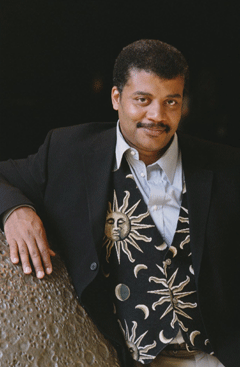
Dr. Neil deGrasse Tyson (Courtesy of Dan Deitch)
[LAUGHING]
TYSON: It’s the cutest thing.
[LAUGHING]
CURWOOD: So why were people really ticked off at you and so upset. Science is constantly changing. Why all the upset about Pluto?
TYSON: The upset wasn’t everybody. The people who were most upset were Americans - because an American discovered it. Europe, they couldn’t care less what you call Pluto. And so, thinking long and hard about this, I could not help but blame at least part of this emotional attachment on the fact that we have a dog named Pluto owned by Mickey, drawn by Disney. What else do we have to show the world but our computers, our jets and Disney?
CURWOOD: So in order for the vote to come down against Pluto, the scientific community had to define what planets are. So, Neil Tyson, tell me: what are planets exactly and what else do we know about the nether regions of our solar system?
TYSON: So they got, in the end, defined by vote to be an object large enough to be round - because if you’re large enough, gravity forces you to be round. That’s criterion number one. Number two: do you dominate all other objects that share your orbit. If those two criteria apply to you, then you are a planet. Pluto is round, but there are thousands of other objects in orbit with it in the Kuiper belt comet. It hasn’t cleared its orbit. It’s a dwarf planet.
CURWOOD: Is that politically correct, though? I mean, is it fair to discriminate against dwarves?
TYSON: [laughs] No. But science – actually, I have to say quickly, when Pluto has demoted Mickey issued – Mickey Mouse issued a memo to the Disney community saying that it’s okay that Pluto was demoted because the Seven Dwarves will now welcome him as an eighth dwarf.
[LAUGHING]
TYSON: So. And those dwarves are no less loveable for being dwarves. In fact, they’re more loveable. So they voted that Pluto would not be considered a planet, and a new word was introduced for round objects beyond Neptune – they’re called Plutoids. So Pluto is sort of the benchmark case of a Plutoid. And there are many people who didn’t like the vote.
CURWOOD: This all sounds very political. In fact, even though the scientific community changed the nomenclature, a couple of states refused to accept that Pluto is a dwarf planet. I’m look, as a matter of fact, in your book – you have in your appendix California legislation relative to Pluto’s planetary status. It says that “the mean spirited International Astronomical Union decided to disrespect Pluto by stripping Pluto of its planetary status and reclassifying it as a lowly dwarf planet.”

CURWOOD: What about Jupiter? Now, as I understand - in fact, I think Neil Tyson once told me that Jupiter give off more energy than it takes in. So…
TYSON: That’s right.
CURWOOD: …isn’t it some kind of a star rather than a planet?
TYSON: Well, so here you go. So, rather than have the word planet refer to something so large and gaseous and energetic as Jupiter in the same breath as something as small as Pluto that’s icy, that’s not any longer a useful word if both of those objects are in the same classification. So why not think of the solar system as all kinds of objects that you might want to think about and talk about. Jupiter gives off more energy than it takes in. That’s a certain kind of planet. In the old days, all there were were points of light in the sky. Maybe you knew what color they were. So you put them all together, call them planets. You’re done. But now we’ve been there, we’ve landed on them. We know what they’re made of. They’ve got magnetic fields and atmospheres and methane and carbon dioxide and moon systems and rings and there’s too much else to talk about to sit there and smile because you can recite the names of what you think is the important category called the planet.
CURWOOD: By the way, you mentioned methane.
TYSON: Ooh, yeah, that slipped out.
CURWOOD: … on the other planets. So what’s going on with – what’s this about methane on Mars. I mean, to me, I mean, you get methane from a garbage dump. Does that mean something is rotting there?
TYSON: You can get methane in a bunch of ways. But one of the easiest ways to get methane is by the action of microbes, microbes that digest their food in environments were there is little to no oxygen. And not only that, methane doesn’t last very long chemically. So if you see it anywhere, as it has been discovered on Mars, just recently – if you see it, it means it’s been freshly made. So, what’s tantalizing is the prospect that this methane is a biomarker for the actions of microbes deep within the soils of Mars.
CURWOOD: Which would mean, of course, life on Mars.
TYSON: Life on Mars. Not the kind with antennae and ray guns, but microbes would be just fine. If you’re a biologist any kind of life at all to compare with life on earth is – would transform the field.
CURWOOD: Neil deGrasse Tyson is an astrophysicist and author of the new book “The Pluto Files: The Rise and Fall of America’s Favorite Planet.” Mr. Tyson, thank very much.
TYSON: Thanks for having me.
Related links:
- For more on the book “The Pluto Files: The Rise and Fall of America’s Favorite Planet,” click here
- Check out Neil deGrasse Tyson’s website
[MUSIC: Real PD “We’re Downsizing Pluto” from For Those About To Pop (Real PD 2007)]
CURWOOD: On the next Living On Earth….
[SOUND OF REBEC]
We travel to Bulgaria, where Gypsy buskers used to perform with dancing bears in exchange for money. The bears were often mistreated, but now they have their own retirement home with fresh fruit meals local people can only wish for. It’s a bear’s life in Belitsa - next time on Living on Earth.
We travel to Bulgaria, where Gypsy buskers used to perform with dancing bears in exchange for money. The bears were often mistreated, but now they have their own retirement home with fresh fruit meals local people can only wish for. It’s a bear’s life in Belitsa - next time on Living on Earth.
[SOUND OF RAIN AND SLEET ON WINDOW]
CURWOOD: We leave you this week in a winter gray.
[SOUND OF RAIN AND SLEET ON WINDOW: John Hudak from Day Of Sound (Earthear.com)]
CURWOOD: On a cold New York day, the pitter patter - well, it’s more like a slushy rattling - of rain and sleet create this soundscape as they hit a window. John Hudak recorded these wet tunes as part of a CD called “Day of Sound.”
Living on Earth is produced by the World Media Foundation. Our crew includes Ashley Ahearn, Bobby Bascomb, Eileen Bolinsky, Bruce Gellerman, Ingrid Lobet, Helen Palmer, Mitra Taj and Jeff Young, with help from Sarah Calkins and Marilyn Govoni.
And congratulations to Jeff Young and his wife Helen on the birth of their baby girl, the same day that the president was sworn in. Now some of us think they should name her Michelle, others think the right name is Baracka.
Our interns are Lindsay Breslau and Liz Gross. Jeff Turton is our technical director. Alison Lirish Dean composed our themes. You can find us anytime at loe.org.
I’m Steve Curwood. Thanks for listening.
ANNOUNCER: Funding for Living on Earth comes from the National Science Foundation, supporting coverage of emerging science, and Stonyfield Farm: organic yogurt and smoothies. Stonyfield pays its farmers not to use artificial growth hormones on their cows. Details at stonyfield.com.
Support also comes from you our listeners, the Ford Foundation, the Town Creek Foundation, and the Oak Foundation, supporting coverage of climate change and marine issues; The Bill and Melinda Gates Foundation, dedicated to the idea that all people deserve the chance to live a healthy productive life. Information at gates foundation.org; and Pax World Mutual Funds: socially and environmentally sustainable investing. Pax World: for tomorrow. On the web at paxworld.com.
ANNOUNCER: PRI, Public Radio International.
Living on Earth wants to hear from you!
Living on Earth
62 Calef Highway, Suite 212
Lee, NH 03861
Telephone: 617-287-4121
E-mail: comments@loe.org
Newsletter [Click here]
Donate to Living on Earth!
Living on Earth is an independent media program and relies entirely on contributions from listeners and institutions supporting public service. Please donate now to preserve an independent environmental voice.
Newsletter
Living on Earth offers a weekly delivery of the show's rundown to your mailbox. Sign up for our newsletter today!
 Sailors For The Sea: Be the change you want to sea.
Sailors For The Sea: Be the change you want to sea.
 The Grantham Foundation for the Protection of the Environment: Committed to protecting and improving the health of the global environment.
The Grantham Foundation for the Protection of the Environment: Committed to protecting and improving the health of the global environment.
 Contribute to Living on Earth and receive, as our gift to you, an archival print of one of Mark Seth Lender's extraordinary wildlife photographs. Follow the link to see Mark's current collection of photographs.
Contribute to Living on Earth and receive, as our gift to you, an archival print of one of Mark Seth Lender's extraordinary wildlife photographs. Follow the link to see Mark's current collection of photographs.
 Buy a signed copy of Mark Seth Lender's book Smeagull the Seagull & support Living on Earth
Buy a signed copy of Mark Seth Lender's book Smeagull the Seagull & support Living on Earth

